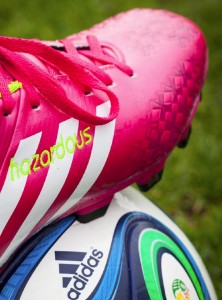Greenpeace launches another attack on sportswear brands concerning hazardous chemicals
 The upcoming football World Cup 2014 in Brazil is the biggest sports event in the world this year. Sportswear giants adidas, Nike and Puma are expecting big business of their merchandise. At this moment, only a couple of weeks before the big event finally takes off, Greenpeace launched another heavy attack on sportswear giants adidas, Nike and Puma by releasing a report titled “A red card for sportswear brands – hazardous chemicals found in world cup merchandise” [1],[2]. The merchandise which was examined was sold in European stores and manufactured mostly in Asia (China, Indonesia, Vietnam and a few other countries).
The upcoming football World Cup 2014 in Brazil is the biggest sports event in the world this year. Sportswear giants adidas, Nike and Puma are expecting big business of their merchandise. At this moment, only a couple of weeks before the big event finally takes off, Greenpeace launched another heavy attack on sportswear giants adidas, Nike and Puma by releasing a report titled “A red card for sportswear brands – hazardous chemicals found in world cup merchandise” [1],[2]. The merchandise which was examined was sold in European stores and manufactured mostly in Asia (China, Indonesia, Vietnam and a few other countries).
The latest report continues a series of Greenpeace studies under the Detox campaign. Earlier studies focused on PFCs in outdoor [3], surfactant residues in textiles (NPEOs)[4] , and toxic chemicals in childrenswear[5]. Greenpeace, the international NGO, even introduced a new kind of fashion catwalk[6] wherein adidas and Nike have been blacklisted as “greenwashers”. Around the same time when Greenpeace launched their Detox campaign, leading fashion brands have established the ZDHC (zero discharge of hazardous chemicals) programme aiming to eliminate hazardous chemicals from their supply chain by the year 2020. Many people say ZDHC was a response to the Detox campaign although this is not officially acknowledged.
To read the full article, please login. The full content of this article and all premium articles is available exclusively for site members.
Site membership is free. If you are an existing user, please login. New users may register below.


